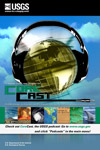USGS CoreCast
USGS Podcasts Home > CoreCast Home Page
Can't see Flash? Install Flash Player.
|
43
|

A huge sinkhole in Texas begs a few questions about this fascinating and sometimes hazardous phenomenon, so we sit down with USGS geologist Randy Orndorff to learn more.
Type: audio/mpeg
File Size: 4780766 bytes Duration: 4:54 Released: Fri, 9 May 2008 15:54:52 UTC |
Transcript:
Scott Horvath:
Welcome and thanks for listening to a USGS CoreCast. I'm Scott Horvath. Today I'm sitting here with Randy Orndorff, a geologist at the U.S. Geological Survey. Recently in the news there's been events related to sinkholes most recently like the one in Texas and I wanted to talk to Randy about what exactly a sinkhole is, how do they form, and are there areas of the country that are more susceptible than others. Randy, thanks for joining us.
Randy Orndorff: My pleasure.
Scott: So recently in the news there's been obviously some events related to sinkholes, very recently the one in Texas. Can you give us a little break down about what exactly is a sinkhole and how these things form?
Randy: Yeah, Scott. Sinkholes form in areas where rocks can dissolve, basically soluble rocks exist, for instance in Texas this is an area where they had salt domes, and obviously salt is very soluble and can catastrophically collapse. Also areas around the country that are underlain by limestone and gypsum, also sinkholes can occur. They tend to form as bedrock caverns have voids underneath them, basically holes in the in the bedrock in the earth and the soil layers above tend to get flushed down those cavernous areas and as they build up and the voids grow toward the surface at some point the surface cannot hold itself any longer and actually catastrophically collapses. The video that we saw this week from Texas is an excellent example of this happening.
Scott: Are there different types of the sinkholes or is there just one generic kind or is there more than one? Can you explain that?
Randy: Actually, we can categorize sinkholes into two types the cover collapses, collapse sinkholes that we saw this week in Texas, for instance, and also there are sinkholes that form slowly over time that the ground just tends to slowly subside or deflate underneath the ground.
Scott: Are there areas of the country that are more susceptible than others to sinkholes, to possible sinkholes?
Randy: Absolutely. About 25 to 30% of our country is underlain by what we call karst terrain. These are areas where you have this soluble rock, the limestone, the gypsum, and the salt. Although not all areas like that will form sinkholes because you have to have precipitation and other events that might happen...all those areas are potentially hazardous for sinkholes, collapse sinkholes.
Scott: Is there, is there a way to for someone to determine if they have a sinkhole on their property or area?
Randy: Yeah, that's a difficult question. It would be nice to be able to tell if there are voids, these holes underneath your property. But we just don't have a very good way to do that yet. The best thing people can do is observe. It's very important to look around to see if you see some small holes opening up in your property, looking for cracks in your foundation in these areas that are susceptible. Most people don't know they live in areas that are underlain by limestone or gypsum and they might want to check with their county offices, local, state geological surveys, the USGS to find out if they are in susceptible areas like that.
Scott: Are there places within the USGS Web site, or other places that someone can go to, to sort of see these geologic maps where these types of minerals might be located?
Randy: Yeah, at the USGS, we have the National Geologic Mapping Program Web site that also includes the National Geologic Map database and this includes a catalog of all geologic maps for the country including ones published by state geological surveys and the US Geological Survey.
Scott: Great. And that does it for this episode of the USGS CoreCast. Thanks for listening. And don't forget to visit our Web site at usgs.gov/corecast. We you can find transcripts, links, and more related to this podcast and all the podcasts that we've done in the past.
And while you're listening, the USGS CoreCast team would like to say thank you to everyone who subscribes and listens to our podcasts. Because of you, and you support, the USGS has recently won two awards for podcasting series. One was the first-place prize in the podcasting category for the National Association of Government Communicators. The other, an Excellence Award from the International Association of Business Communicators for the Electronic and Digital Communications Skills category. So once again, thanks for listening.
Don't forget, CoreCast is a product of the US Geological Survey, Department of the Interior. Until next time I'm Scott Horvath saying, "Keep it cool."
Music credit:
"The Mystic 1" by calpomatt
Resources related to this episode:


